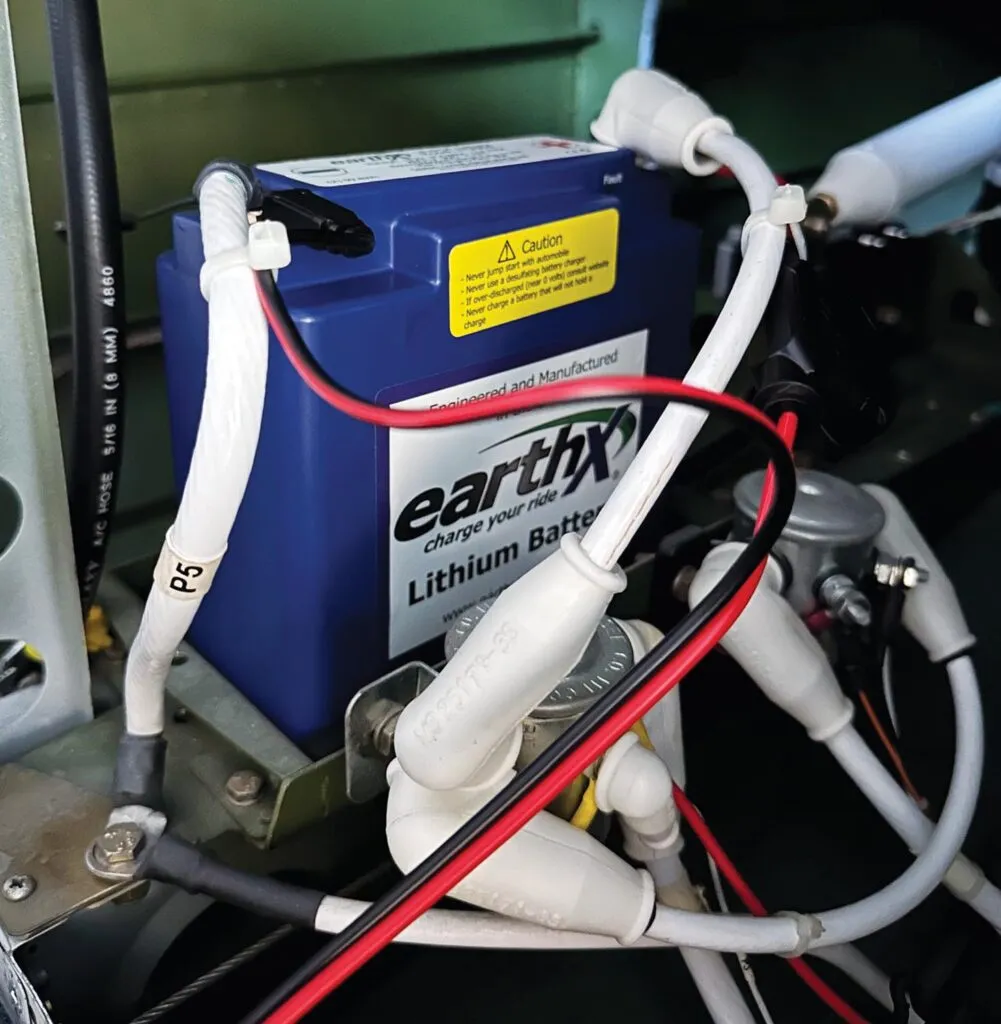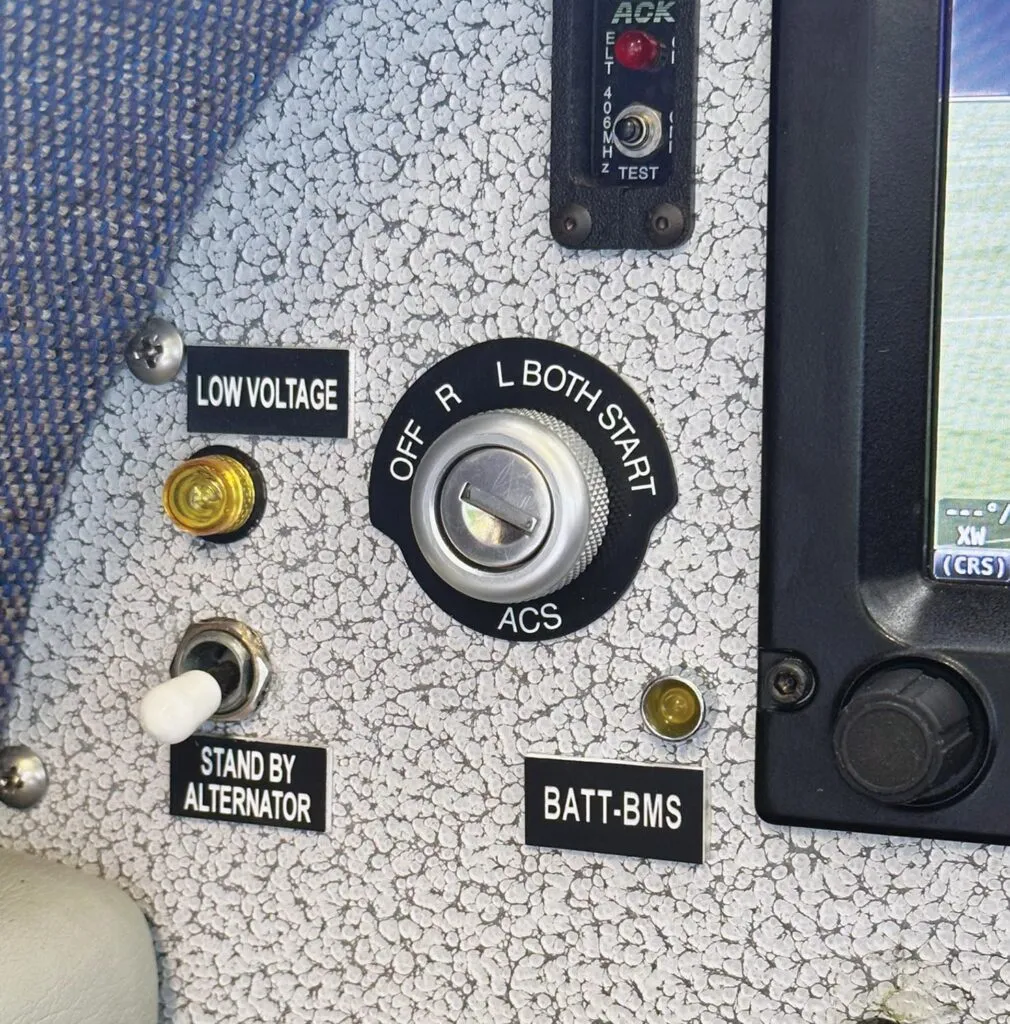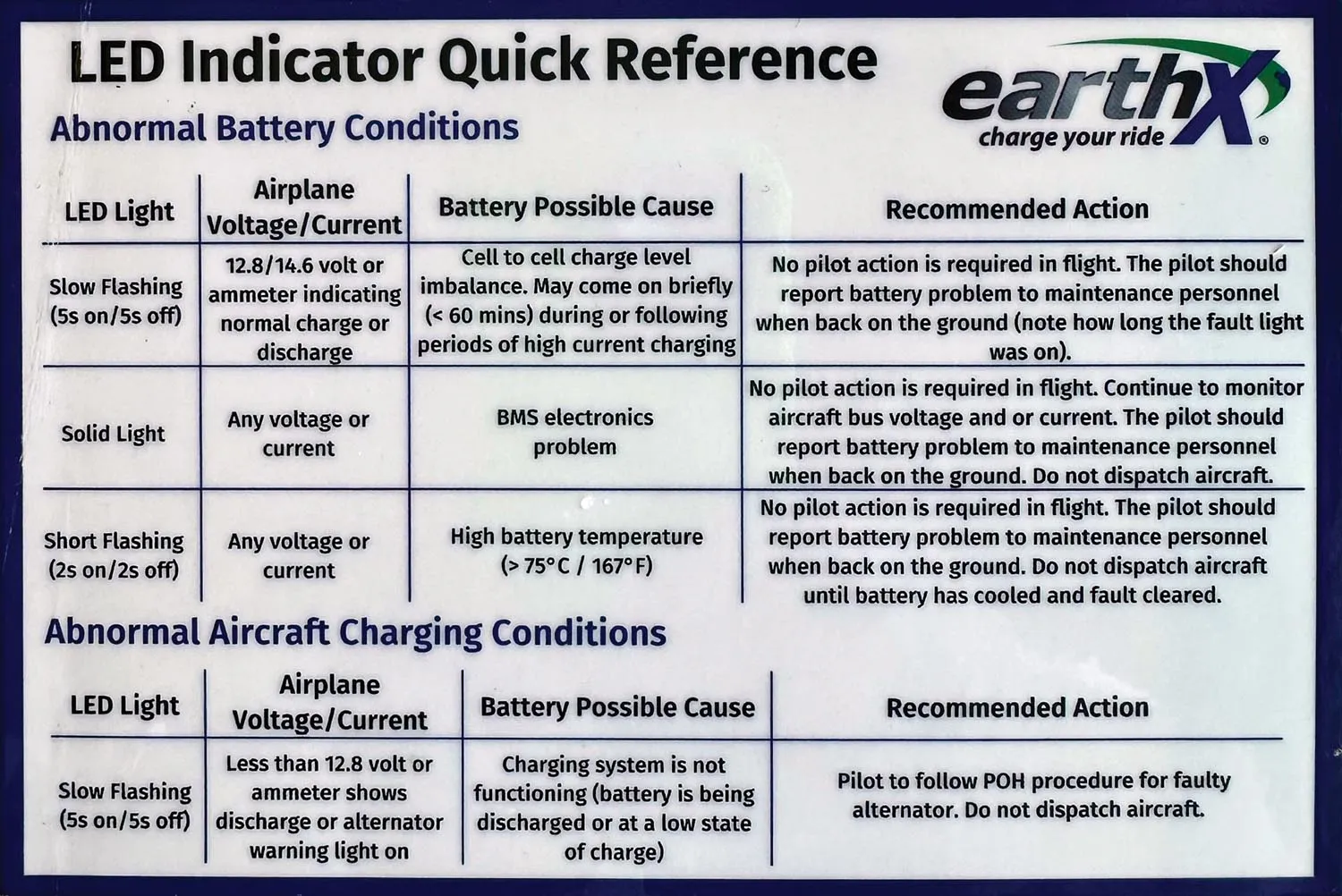
We’ve all been there. The airplane is pulled out and baking on the hot ramp. Preflight complete. Passengers and bags are loaded and ready to go. Systems powering up seem normal. Battery voltage is a tad low, but still above 12 volts. Hit the starter and you’re rewarded with a weak quarter turn of the prop and then some pathetic clicks as the volts drop off a cliff. Arrgggh! I hate this kind of triptus interruptus. I should have realized that I was due as in over nine years of using Odyssey PC680 batteries, I was averaging about three years per, and it had been about three years since the last installation.
Lead-acid batteries, even in the more up-to-date absorbed-glass-mat format, are very old technology. Modern lithium-based batteries were making inroads during my build period, but I had seen published evidence of charred remains in both RC models and early Boeing 787s. According to EarthX, their battery chemistry is different than the aforementioned battery types and is safer and more stable. Back then I was being cautious and decided to hold off to let the technology mature and prove itself.
Technological innovation is an aeronautical tradition, but early adopters pay a price. Efforts to maximize energy efficiency can produce temperamentalism as a byproduct. I started my airline career flying Boeings with Pratt & Whitney JT8Ds and finished with the latest CFM Leaps. The latter are certainly more efficient, but there’s no doubt the newer technology has kinks to be worked out while the Pratts are, shall we say, fully unkinked. Hyperefficiency is good, but there is a legitimate fondness for the old Pratts. As the mechanics used to say, “They may be thirsty but if you toss gravel into the front, you’ll get sand out the back.”
Batteries of Today
Back into the battery market once again, I decided to take a renewed look at the modern offerings now that they have had time to prove themselves. Like next-gen engines, new battery science uses exotic materials and computer-chip control to squeeze more power, efficiency and longevity out of your battery box. After studying the market offerings, I decided to purchase an EarthX LiFePO4 for my RV-10 and give it a try. As I’ve mentioned before, I am not a technical type. I’m not going to tear the thing down and do exotic tests, showing the results on charts and graphs. I’m just sharing my experience from the standpoint of John Q. Enduser on the process of installing and using this new technology.
For my RV-10, I ordered the ETX900 directly from the manufacturer. This is the unit they recommended for my application. At $449, it is roughly 2.5 times the going rate for the Odyssey I was replacing. Obviously, the promise (hope) of longer service life is a big part of justifying the higher cost. The package arrived within a couple of days, which was a pleasant surprise considering the supply chain follies of the recent past.
One of the primary advantages to installing lithium batteries is weight savings. Those savings are significant. In unscientific home testing, the Odyssey showed 14.2 pounds and the EarthX registered a svelte 4.7 pounds—nothing to sneeze at. To put it another way, the savings effectively countered the two W&B adds I’ve made since the first flight, being the Dynon yaw damper servo and the B&C standby alternator. Rarely does any upgrade equate to a weight savings like this one does.
The Second Generation
One of the things that helped to assuage my hesitance at adopting a new-tech battery is that the current model recommended for my application is labeled a “Gen 2” product. According to EarthX, this second-generation battery has new cell construction that reduces the risk of a thermal runaway by 400%. It also has 20% longer shelf life, enhanced short-circuit and overvoltage protection and is easier to recharge when in its “discharge protection mode.”
These new battery designs require active onboard management and monitoring to protect the battery and its host. In the EarthX, the battery management system (BMS) consists of an integrated circuit board encased atop the battery. The BMS balances the individual cells and monitors charge and discharge. Some of the improvements integrated into the second-gen series came from enhancing the BMS. For BMS operational monitoring, the battery case includes an LED to display abnormalities by specific flash codes, plus there’s a pigtail lead to connect to an external warning light or EFIS widget for the same purpose.
Installation
Installation of the battery is quite simple. By design, the battery is non-spillable and can be installed in any position or orientation. Its light weight makes mounting decisions even easier. There are various mounts and boxes available from EarthX and other vendors for horizontal, vertical, firewall and so on. Some builder forums have links to software offerings for those interested in 3D printing their own box. In my particular case, I found the footprint of the battery to be practically identical to my previous Odyssey 680 batteries and the standard Van’s mounting tray to be sufficient with the same spacer blocks I had previously used.

Where the installation process gets slightly more complicated involves accommodating the BMS indicator light. In the Van’s RV-10, the standard location for ship’s battery is in the empennage just aft of the cargo compartment bulkhead. The good news is that when I built and wired the airplane, I ran an extra five leads from the aft area to the instrument panel area. Therefore, I had an available lead already run and ready to go. The bad news is that after installing things like a 406 ELT with GPS, a yaw damper system and some lighting upgrades, the BMS install consumed my last available lead. Fortunately I also ran a fish string when I built for the next upgrade I haven’t thought of yet. Note to builders—run plenty of well-marked extra wires.
Now back to the BMS indicator. The cockpit indicator can be either a widget programmable into most EFISes or a separate (amber) light installed in an appropriate place so as to be readily noticeable. I vacillated on this decision until I ultimately decided to install a separate physical light and ordered the $29 LED assembly option from EarthX, though any similar light rated for the appropriate voltage would work. My reasoning was that with the way my twin 7-inch Dynon SkyView displays are configured, I don’t really have any available screen real estate for an additional widget, especially for one that hopefully will never be used. Also, I have a far corner of my panel where I already had an indicator light for my B&C standby alternator and decided that the BMS indicator would be easy to install and would look “at home” there.
The actual wiring of the warning light is easy enough. The lead from the BMS pigtail takes the circuit to ground when activated. Power for the light can piggyback off of any positive terminal downstream of the master switch. The light only illuminates if there is a problem and, depending upon the anomaly, will illuminate steady or flash either fast or slow.

My only quibble with the design is that there is no way to test the system for functionality. After over 35 years of airline flying, that seems odd to me. In airliners, practically every warning system gets tested daily if not every flight. As confirmed with EarthX tech support, as close as one can come to a system test is to unplug the BMS lead at its pigtail at the battery and then touch the terminal end to battery ground. If the positive side has power, the light will illuminate. That will test the light circuit but not the BMS itself.
Power Up
The real test for any starter battery is actually starting the engine. In my case, an IO-540 with higher-than-standard compression. As I got ready to engage the starter, I had a new magic battery that had zero external charge since removed from the box, plus about 20 minutes of panel operation. It showed 13.1 volts on the Dynon. For about 900 hours of Odyssey starts, I was used to a “soft” starter engagement that would intensify after the prop started turning. This time was different. It is hard to describe, but it was like the starter got hit with a hard punch. The effect was immediately noticeable: The engine started quicker and more energetically.
Like most builder/operators, I severely dislike dispatch reliability problems and appreciate bang for the buck, even if at a higher initial investment. I’m still new to the lithium world, but so far I am impressed and satisfied. If the projected life span increase pans out and the battery never gets angry on me, I’ll be glad I got the lead out.
